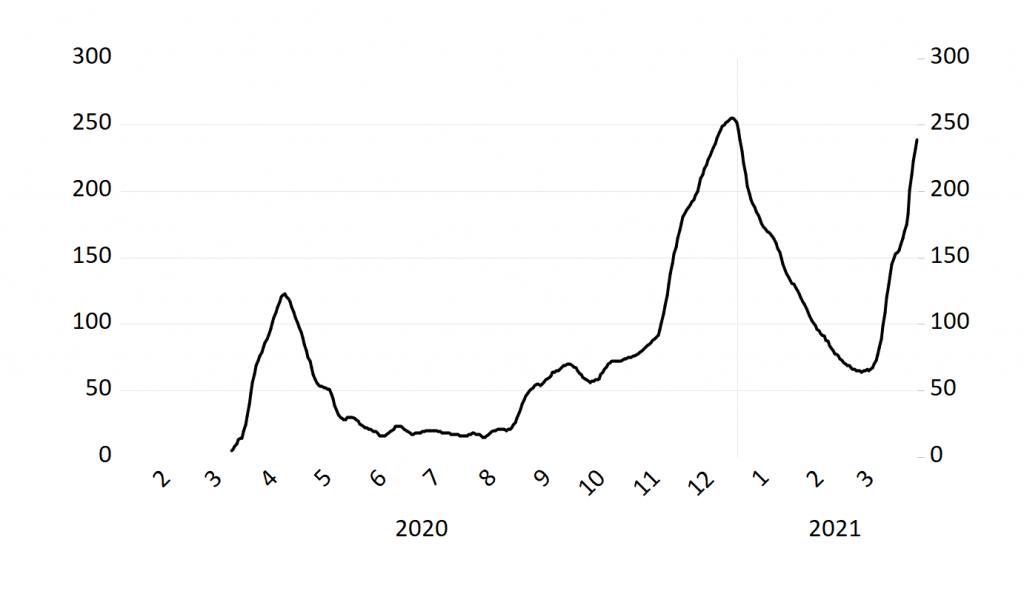

As the pandemic hits with the third wave, the scientists exploit the year-long data to dig deeper into the pandemic and learn its dynamics.
While Turkey displayed a relatively succesful performance at the early stages of the pandemic, it is one of the countries with the largest number of daily infections at the moment.
Daily number of deaths in Turkey

About one year ago, I had discussed the preliminary findings of our work on the economic costs of lockdowns. In that work, we had noted that an early and strict lockdown saves the most number of lives and minimizes the economic costs at the same time. Almost one year after the pandemic, international growth numbers support our predictions. Although very few countries implemented early and full lockdowns, the ones that did implement full lockdowns such as China and New Zealand were able to contain the pandemic sooner and normalize their economies faster. Meanwhile, many countries who opened up their economies prematurely are dealing with the second or the third waves of the pandemic. An increase in the number of infections combined with the “fear factor” reduces consumption. Consequently, countries announce stimulus packages that are worth billions and trillions of USD and still cannot reach the desired level of growth.
In our aforementioned work, we had estimated the economic costs of lockdowns under different scenarios that correspond to the low and high efficiency of such measures. We had not investigated the determinants of the efficiency of a given set of measures. In our recent work with Cem Çakmaklı, Sevcan Yeşiltaş, and Muhammed Ali Yıldırım from Koç University, we investigate the cross-sectional differences in the number of infections across countries. We ask the following question: How come some countries are more successful than the others in reducing the number of infections, for a given set of stringency measures?
Using daily data from 47 countries, we reach the following conclusions: In those countries with well-established rule of law, credibility in policymaking and hence more obedience to the rules and regulations announced by the government, the pandemic can be controlled more effectively. Consequently, a given set of stringency measures perform better in reducing the number of infections.
Rule of law and credibility
Rule of law and credibility are the two preconditions for macroeconomic stability and sustainable growth. They are necessary to nourish the investment environment, reduce country risk, increase potential GDP, enable financial deepening and hence increase the overall welfare.
Our recent findings highlight that the rule of law and credibility are also indispensable when it comes to the fight against the pandemic. A country with stronger rule of law and credible policies is more successful in containing the pandemic. This is because there is a higher tendency to stick to the rules and regulations in these countries, which controls the number of cases. Ceteris paribus, these countries do not need stricter lockdown measures to contain the pandemic, which lowers their economic burden.
Empirical analysis
Let me provide more details about our work for the interested readers. Proper reading and interpretation of the data is crucial in economics, just like any empirical science that works with data. Accurate analysis of the data complements theoretical predictions and allows the field to move forward. Improper analysis, in contrast, can lead the field in the wrong direction.
In order to determine the efficiency of the stringency measures, we first need to establish the relationship between lockdown measures and the number of infections. This provides the basis to estimate the factors that affect this relationship. Although we expect stricter measures to lower the number of infections, this may not be as easy to detect in the data due to the presence of reverse causality. In particular, an increase in the number of infections prompts governments to adopt stricter measures. If this endogeneity is not properly addressed, one can reach the improper conclusion that stricter measures increase the number of infections. This seemingly innocent econometric error can cause policymakers to draw wrong and dangerous conclusions in an environment of elevated uncertainty where the efficiency of the lockdown measures are questioned.
There is an abundance of examples in the economics literature where improper inference is drawn from reverse causality. The relationship between inflation and interest rates is one such example. On the one hand, inflation causes interest rates to increase through the expectations effect. On the other hand, an increase in interest rate lowers the inflation rate with a lag. If this endogeneity is not properly addressed, one can reach the inaccurate conclusion that “interest rate causes higher inflation.”
Going back to our topic, after we control for endogeneity, we first establish a negative significant relationship between the stringency measures and the number of cases. Specifically, a major increase in the number of stringency measures reduces the number of new cases by 6 percent on average.
At this stage, we analyzed the effects of the rule of law and obedience on the effectiveness of the stringency measures. In a country with strong rule of law, an increase in stringency measures is associated with an additional 10 percent decline in the number of cases. Similarly, in a country where there is trust in policy decisions and hence more obedience, there is a 0.5 percent additional decline in the number of new cases.


